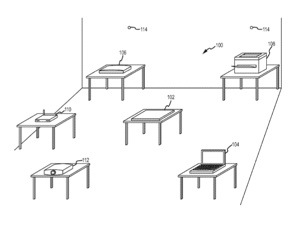An Apple patent (number 20110162048) involving local device awareness has appeared at the US Patent & Trademark Office. Aspects of the present disclosure (think iOS devices) relate to the operation of electronic devices and, more particularly, to identifying and placing electronic devices located within a particular vicinity.
Per the patent, certain embodiments may take the form of a method of operating an electronic device to find and determine an identity of other local devices. The method includes transmitting electromagnetic signals from a first electronic device to find devices within a prescribed distance of the first device and receiving electromagnetic response signals from a second electronic device within the prescribed distance from the first electronic device.
The method also includes identifying the second electronic device using information received in the electromagnetic response signals. Additionally, the method includes determining if the second electronic device is aware of other electronic devices and, if the second electronic device is aware of other electronic devices, obtaining identifying information of the other devices from the second electronic device. The inventors are Brett Bilbrey, Aleksander, Nicholas Vincent King and Benjamin Todd.
Here’s Apple’s background and summary of the invention: “Network-enabled electronic devices commonly communicate instantly over great distances. A network connection allows these devices to be in communicative proximity. That is, the devices communicate generally without reference to any distance between the devices.
“However, communicative proximity is not necessarily equal to physical proximity. For example, a computer in an office may be able to interact with a number of printers via a network, even if these printers are not physically near the computer. Indeed, the printers may be located on another side of, or on a different floor of, an office building, making use of the printers inconvenient. In some cases, a user of the computer may be aware of a local printer but unable to find the local printer via the network.
“Certain aspects of embodiments disclosed herein by way of example are summarized below. It should be understood that these aspects are presented to provide the reader with a brief summary of certain embodiments disclosed and/or claimed herein and that these aspects are not intended to limit the scope of any claims or disclosure. Indeed, any embodiment disclosed and/or claimed herein may encompass a variety of aspects that may not be set forth below.
“Certain embodiments relate to determining spatial proximity of electronic devices. Specifically, some embodiments include a method of operating an electronic device to find and determine an identity of other local devices. The method includes transmitting electromagnetic signals from a first electronic device to find devices within a prescribed distance of the first device and receiving electromagnetic response signals from a second electronic device within the prescribed distance from the first electronic device. The method also includes identifying the second electronic device using information received in the electromagnetic response signals. Additionally, the method includes determining if the second electronic device is aware of other electronic devices and, if the second electronic device is aware of other electronic devices, obtaining identifying information of the other devices from the second electronic device.
“Other embodiments include a method of operating a stationary electronic device to facilitate communications between devices within the vicinity of the stationary device. The method includes scanning the vicinity of the stationary device using a first electronic device to determine if other devices are present and determining that more than one other device is present in the vicinity. An identity of each of the more than one other device present in the vicinity is determined and each of the more than one other device is provided with the identifying information of the more than one other devices.
“Still other embodiments include an electronic security device. The electronic security device includes a processor and a memory coupled to the processor storing operating instructions for the electronic security device. Additionally, the electronic security device includes one or more vicinity sensors configured to determine when other electronic devices are in a vicinity of the electronic security device. When other electronic devices are determined to be within the vicinity of the electronic security device, the electronic security device determines an identity of the other devices and grants access to a document to the other devices while the other devices are determined to be within the vicinity of the electronic security device.”
— Dennis Sellers

